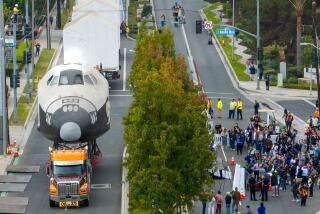Launching soon
For more than two decades, officials at the California Science Center dreamed of showcasing a space shuttle at the Exposition Park museum.
It took a nationwide competition, a three-day cross-country flight and a harrowing 12-mile trek through the streets of Los Angeles, but on Tuesday, that dream will come true.
The free, state-run museum will open its doors to the display pavilion housing the retired orbiter Endeavour, which arrived at the Science Center about two weeks ago. The 18,000-square-foot building will showcase the museum’s prized exhibit until a new air and space wing is built.
“Obviously people were excited just to see it fly over or even [get] a closer look when they could see it going down the streets, but here they get a lot more of a chance to see it,” Science Center President Jeffrey Rudolph said. “People can learn a lot more about it.”
There are two separate parts to the temporary set-up: the Samuel Oschin display pavilion and another exhibit detailing the space shuttle’s history and ties to Southern California. The entire space shuttle fleet -- Columbia, Challenger, Discovery, Atlantis, Endeavour and Enterprise, the test orbiter -- was assembled in Palmdale.
Museum visitors won’t be able to go inside the 122-foot-long Endeavour, but they can virtually navigate the flight deck, mid-deck and payload bay by using a touch-screen display. Officials also removed the shuttle’s galley and toilet to show separately.
“It looks like a porta-potty,” one fifth-grader said of the latter at a preview last week.
Tucked in the corner of the display pavilion is one of the massive engines that propelled Endeavour into space. Designed, built and tested by Canoga Park-based Rocketdyne, the 14-foot-long boosters were the first reusable engines used by NASA.
Each time the shuttles launched, a Rocketdyne team would pore over data from a support center at its San Fernando Valley plant, making sure the engines were ready for takeoff and performed properly during their 81/2-minute burn.
The support center has been reassembled inside the museum as part of the shuttle display. All of the pieces are original to the Canoga Park facility, down to the maroon chairs and computer keyboards.
“I hope that when people see this hardware they’re able to appreciate the technological complexity and technological difficulty of putting the shuttle into space and keep it going for all these years,” said Mike Carlson, a Rocketdyne engineer who once managed the support center. “It wasn’t easy.”
And then there’s Endeavour itself.
Visitors will be able to walk underneath the orbiter’s weathered underbelly, so close one can read the small, white lettering on each tile. Near the rear of the shuttle, there are about a dozen tiles that were damaged during Endeavour’s 25th and final mission, revealing what looks like Styrofoam underneath.
“It’s amazing,” said Diane Perlov, the museum’s deputy director of exhibits. “The first time I saw it -- it brings tears to your eyes. It’s really something.”
The shuttle will be even more impressive in its permanent home in the Samuel Oschin Air and Space Center, Rudolph said. There, the shuttle will be displayed vertically as though it is about to launch, complete with an external tank and twin solid rocket boosters. That 170,000-square-foot facility, which will also feature exhibits on flight and space exploration, should open in about five years, Rudolph said.
Money for the temporary and permanent displays will come from a $200-million fundraising campaign. Rudolph said about 80% of that is earmarked for the new air and space wing.
“When we have it standing up vertically, there’s nothing in the world like it,” Rudolph said. “If you’re going to see one space shuttle, this is going to be it.”
The two other museums that house retired shuttles -- the Intrepid Sea, Air and Space Museum in New York City and the Smithsonian Institution’s Steven F. Udvar-Hazy Center in Virginia -- both have reported increased attendance since their orbiters went on display. Rudolph said he expects the same boost for the Science Center, guessing the shuttle would bring attendance to about 2 million people per year, up from about 1.5 million.
Museum and NASA officials have repeatedly expressed their hope that Endeavour will encourage the next generation of engineers, scientists and astronauts.
“This thing will inspire kids to want to be astronauts,” said retired astronaut Mark Kelly, who commanded Endeavour’s last mission. “Maybe one of those little kids that will be looking up at this space shuttle will one day go and walk on Mars for the first time.”
Amy Davis is a fifth-grade teacher at Inglewood’s Century Park Elementary School. Her class watched last month as Endeavour, riding a jumbo jet, flew low over the school on its way to the Los Angeles International Airport. The children shrieked with glee as it passed over their heads.
Two students ran up to Davis. Ten-year-old Richard Hercules had tears streaming down his face.
“They’re happy tears,” Richard’s friend told their teacher.
Richard has wanted to be an astronaut as long as he can remember. He “felt lucky” he got to see Endeavour, he said.
“That’s the only space shuttle I’ve ever seen,” he said. “It gave me a boost of wanting to be an astronaut more.”
Davis wrote to the Science Center, explaining how moved Richard was by the experience. A NASA official heard the story and sent Richard an application to Space Camp in Alabama.
Richard is now working on the application, collecting letters of recommendation and writing an essay on astronaut John Glenn, trying to earn a scholarship so he can go.
“Dreams are possible,” Davis said. “It was meant to be.”
--
More to Read
Sign up for The Wild
We’ll help you find the best places to hike, bike and run, as well as the perfect silent spots for meditation and yoga.
You may occasionally receive promotional content from the Los Angeles Times.







